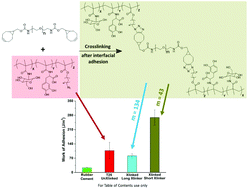当前位置:
X-MOL 学术
›
Polym. Chem.
›
论文详情
Our official English website, www.x-mol.net, welcomes your feedback! (Note: you will need to create a separate account there.)
Synthesis and adhesion control of glucose-based bioadhesive via strain-promoted azide–alkyne cycloaddition†
Polymer Chemistry ( IF 4.6 ) Pub Date : 2018-06-13 00:00:00 , DOI: 10.1039/c8py00339d Irawan Pramudya 1, 2, 3, 4 , Cheoljae Kim 1, 2, 3, 4 , Hoyong Chung 1, 2, 3, 4
Polymer Chemistry ( IF 4.6 ) Pub Date : 2018-06-13 00:00:00 , DOI: 10.1039/c8py00339d Irawan Pramudya 1, 2, 3, 4 , Cheoljae Kim 1, 2, 3, 4 , Hoyong Chung 1, 2, 3, 4
Affiliation

|
A glucose-based bioadhesive, poly(2-methacrylamido glucopyranose-co-N-methacryloyl-3,4-dihydroxyl-L-phenylalanine-co-8-azidooctyl methacrylate) [poly(MG-co-MDOPA-co-AOM)], has been synthesized by thermally-initiated free radical polymerization. The new bioadhesive is composed of three modules: a hydrophilic glycopolymer segment, a mussel-inspired catechol segment, and a crosslinking azide segment. Poly(ethylene glycol) (PEG)-based crosslinker, (1R,8S,9s)-bicyclo[6.1.0]non-4-yn-9-ylmethyl PEG (BCN-PEG) was synthesized separately. Bulk adhesion properties of the terpolymer were enhanced by covalent bond forming crosslinking via strain-promoted azide–alkyne cycloaddition (SPAAC). The occurrence of SPAAC was confirmed by 1H NMR and FT-IR. After moistening the adhesive and the crosslinker, BCN-PEG with water, adhesion properties were examined by a lap shear strength test on porcine skins. The control of adhesion was studied under various crosslinker concentrations, crosslinking durations, and crosslinker lengths. Even without crosslinking, the new terpolymer adhesive demonstrated 20-fold higher adhesion strength (115 kPa) compared to a commercial rubber cement (5.8 kPa). The most significant factor to control for adhesion was crosslinker length. BCN-PEG was prepared with 134 and 43 repeating units of PEG. Crosslinking with the long crosslinker, BCN-PEG (PEG repeating units: 134), did not enhance adhesion strength meaningfully. However, crosslinking the short crosslinker BCN-PEG (repeating units: 43) showed significant improvement in work of adhesion (150% higher than uncrosslinked). The overall revealed features of strong adhesion on biological surfaces, structural similarity to natural carbohydrate, water compatibility, controllability of adhesion strength, and non-toxic adhesion enhancement principle via SPAAC crosslinking, suggest that the new glucose-based bioadhesive can be successfully used for biomedical applications.
中文翻译:

通过应变促进的叠氮化物-炔烃环加成反应 合成葡萄糖基生物粘附剂并进行粘附控制†
甲葡萄糖基生物粘附,聚(2-甲基丙烯glucopyranose-共-N- -methacryloyl -3,4- dihydroxyl-大号-phenylalanine-共-8- azidooctyl甲基丙烯酸酯)[聚(MG- CO -MDOPA-共-AOM)]通过热引发的自由基聚合反应合成了。新的生物粘合剂由三个模块组成:亲水性糖聚合物片段,贻贝启发的邻苯二酚片段和交联的叠氮化物片段。分别合成了基于聚乙二醇(PEG)的交联剂(1 R,8 S,9 s)-双环[6.1.0] non-4-yn-9-基甲基PEG(BCN-PEG)。三元共聚物的本体粘合性能通过形成共价键的交联而增强通过应变促进的叠氮化物-炔烃环加成反应(SPAAC)。SPAAC的发生由1确认1 H NMR和FT-IR。用水润湿粘合剂和交联剂BCN-PEG后,通过在猪皮上的搭接剪切强度测试来检查其粘合性能。在各种交联剂浓度,交联持续时间和交联剂长度下研究了粘合力的控制。即使没有交联,新型三元共聚物粘合剂的粘合强度(115 kPa)也比市售橡胶胶粘剂(5.8 kPa)高20倍。控制粘合力的最重要因素是交联剂的长度。用134和43个PEG重复单元制备BCN-PEG。与长交联剂BCN-PEG的交联(PEG重复单元:134)没有显着提高粘合强度。但是,使短交联剂BCN-PEG交联(重复单元:43)显示出粘合功的显着改善(比未交联的高150%)。总体显示出在生物表面上具有强粘附力,与天然碳水化合物的结构相似性,与水的相容性,粘附力的可控制性以及无毒粘附力增强原理的特征通过SPAAC交联,表明新的基于葡萄糖的生物粘合剂可以成功用于生物医学应用。
更新日期:2018-06-13
中文翻译:

通过应变促进的叠氮化物-炔烃环加成反应 合成葡萄糖基生物粘附剂并进行粘附控制†
甲葡萄糖基生物粘附,聚(2-甲基丙烯glucopyranose-共-N- -methacryloyl -3,4- dihydroxyl-大号-phenylalanine-共-8- azidooctyl甲基丙烯酸酯)[聚(MG- CO -MDOPA-共-AOM)]通过热引发的自由基聚合反应合成了。新的生物粘合剂由三个模块组成:亲水性糖聚合物片段,贻贝启发的邻苯二酚片段和交联的叠氮化物片段。分别合成了基于聚乙二醇(PEG)的交联剂(1 R,8 S,9 s)-双环[6.1.0] non-4-yn-9-基甲基PEG(BCN-PEG)。三元共聚物的本体粘合性能通过形成共价键的交联而增强通过应变促进的叠氮化物-炔烃环加成反应(SPAAC)。SPAAC的发生由1确认1 H NMR和FT-IR。用水润湿粘合剂和交联剂BCN-PEG后,通过在猪皮上的搭接剪切强度测试来检查其粘合性能。在各种交联剂浓度,交联持续时间和交联剂长度下研究了粘合力的控制。即使没有交联,新型三元共聚物粘合剂的粘合强度(115 kPa)也比市售橡胶胶粘剂(5.8 kPa)高20倍。控制粘合力的最重要因素是交联剂的长度。用134和43个PEG重复单元制备BCN-PEG。与长交联剂BCN-PEG的交联(PEG重复单元:134)没有显着提高粘合强度。但是,使短交联剂BCN-PEG交联(重复单元:43)显示出粘合功的显着改善(比未交联的高150%)。总体显示出在生物表面上具有强粘附力,与天然碳水化合物的结构相似性,与水的相容性,粘附力的可控制性以及无毒粘附力增强原理的特征通过SPAAC交联,表明新的基于葡萄糖的生物粘合剂可以成功用于生物医学应用。



























 京公网安备 11010802027423号
京公网安备 11010802027423号